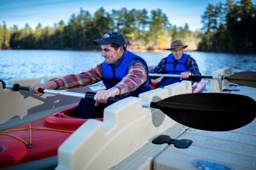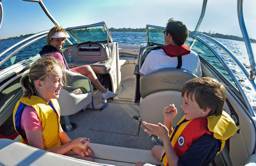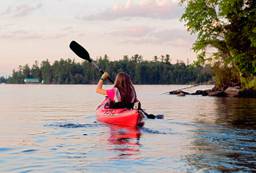By Dan Armitage

No matter whether your cabin is on or near the water, whether your lake restricts motorboats or allows them, having a paddle-craft is a great option. For many of us, nothing beats kayaks, canoes and SUPs (stand-up paddleboards) for a quiet getaway on the water. If you find yourself yearning for a paddle-powered boat, here’s some advice that may help you select the right craft for your needs.
Before You Buy
Determine what you’re looking for, says Dan Mangus with Hobie Cat, manufacturer of a popular line of traditional paddle and pedal-driven kayaks, sailing kayaks and stand-up paddleboards. “Do you want to get out and get exercise, go fishing, explore and take photographs or just get out with a friend and talk?” For example, when someone is considering a tandem or single occupancy kayak, Mangus counters with a question: “Do you own a tandem bicycle or individual bikes? If the answer is, ‘No way we’d share a bike,’ then the answer is obvious,” says Mangus. “On the other hand, a tandem kayak is perfect for couples who want to share the experience or are boating with kids, or if one is a more experienced paddler than the other.” Consider other questions, too, he says, including: “How much experience do you have paddling a boat?” If the answer to that particular question is “None,” Mangus will point to his company’s pedal-driven models because, in his words, “There’s no learning curve; you just get in and start pedaling and steering by pointing a simple lever in the direction you want to go.” And, if your goal is getting exercise, there are plenty of options to consider among boats powered by paddle, as well as pedal.Canoes
Canoes are made of everything from fiberglass, aluminum or Kevlar to a wide range of polymers, as well as wood, canvas or cedar strip. The majority of recreational canoes (and kayaks) sold today are made using polyethylene, which is popular for its combination of affordability and durability. It’s flexible and has a memory, so will return back to its original shape after impact. Polyethylene canoes are lighter than those built using aluminum.
Why buy?
Canoes are generally more stable than kayaks, explains Scott Morris of Grumman Boats, a division of the Marathon Boat Group in Marathon, N.Y. “And they have a greater carrying capacity with regard to passengers and load. Aluminum models also are a good choice for use in rocky waters, where they shrug off rocks that would crack or puncture the hulls of fiberglass and plastic boats, and any resulting dents can be pounded out.” Because a canoe has a displacement hull, no matter what it’s made of, the longer it is, the faster its theoretical top speed and the more weight it can carry. Touring canoes average 16 to 18 feet long and accommodate two or more people and plenty of gear. On the other hand, the longer a canoe is, the more difficult it is to control, especially if you are paddling solo, if it’s windy or if you must paddle cross current. On flat water, a long hull allows the canoe to track straight, and does not require as many corrections. Shorter canoes are much easier to maneuver, are better suited for solo paddlers. Craft as short as 10 feet are good for short paddles, day trips, and whitewater adventures. While easier to steer, shorter canoes typically don’t track as well and require a lot of correction to keep on a straight course in flat water. A good length for a general-purpose camp canoe is 14 to 15 feet, which will easily accommodate two people, but can be paddled solo.
Features to look for:
Seat design that is comfy for you; seat configuration for solo or multiple paddlers/passengers; the hull design, which determines stability and performance capabilities; and weight, especially if portaging.

Kayaks
As with canoes, kayaks are made from a variety of materials. Most recreational kayaks sold today are made of polyethylene, a good choice for typical cabin situations. Much of what holds true with canoes in construction, length and handling can also be said about kayaks. The advantage of kayaks, according to Matt Ross of Pelican International, a leading manufacturer of recreational kayaks and other paddle-craft, is their range of size, weight and affordability.
Why buy?
“You can get anything from a six-foot kayak to a sixteen-foot kayak,” he explains, adding: “Even longer if you want to consider a tandem. And kayaks are easier to transport and paddle, and go farther and faster for the effort than a comparable canoe.” “When you figure that kayaks at cabins are often used by guests, children and people who simply may not know how to care for the boats or may handle them a bit roughly,” advises Ross, “polyethylene is the way to go. Kayaks built with polymers are affordable, lightweight and forgiving of harsh use.” Kayaks come in two distinct configurations, based on the design of the cockpit: sit-in (SI) or sit-on-top (SOT). The SI design offers a traditional cockpit that covers the lower body and is often used in warmer climates and by anglers who need more flexibility; the SOT design requires the paddler to sit atop an open cockpit with the lower body exposed and are popular for touring, white- and open-water use and during cooler weather.
Features to look for: Comfortable seats and backrests; grab handles for carrying; and bungee-corded deck storage and covered storage compartments. Anglers will want to look for built-in rod holders or mounts.
Stand-Up Paddleboards
Stand-up paddleboards are the fastest growing segment in paddle-sports. Hobie Cat, Pelican and RAVE Sports are among a growing number of manufacturers offering popular SUPs, as they are called. As with the other paddle-craft, SUPs can be constructed of a variety of materials, and polyethylene is popular among recreational SUP owners: it’s lightweight, durable and less expensive than watercraft built using other materials. The difference with SUPs is that they require more rigidity than kayaks, so they are constructed using a wide variety of skin materials and cores, from balsa to carbon fiber. '
Why buy?
“For a paddle-sport option that’s a little more challenging than kayaking, try SUPs” explains Ross, whose Canada-based company offers an extensive line of SUPs as well as kayaks. “You use your entire body when paddling a stand-up board, and it takes a little more skill to master the balance and handling required. But once you’ve stood up on the water, it’s tough to go back to a sit-down-type boat.” A variety of styles are available depending on your needs. Inflatable SUPs are a good choice for owners of seasonal cabins and/or who have a minimum of storage space, allowing the SUPs to be deflated and packed away when not in use. RAVE offers a helpful chart on its website (ravesports.com) to help select an SUP of any brand or type, based on its intended purpose. “When selecting an SUP, the length of the board is important to consider in relation to the size of the paddler, as buoyancy is a function of the length of the board,” explains RAVE Sports’ Tanya Rausch. “For optimum performance, it is best to select a size that is suitable for the largest size paddler.”
Features to look for:
A fin under the stern for tracking; bungee cord connection points for on-deck storage; a nonskid deck pad; multiple handle grips for transport and boarding; and an ankle leash option for tethering the board to the paddler when in the water. Staying closer to the water is part of the fun of using any boat powered by a paddle!
Dan Armitage is a cabin dweller, frequent contributor, freelance writer and syndicated radio show host (buckeyesportsman.com) who is based in Ohio.












